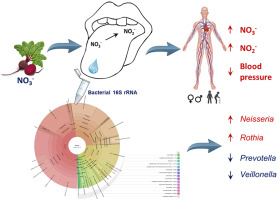Free Radical Biology and Medicine ( IF 7.1 ) Pub Date : 2018-05-25 , DOI: 10.1016/j.freeradbiomed.2018.05.078 Anni Vanhatalo , Jamie R. Blackwell , Joanna E. L’Heureux , David W. Williams , Ann Smith , Mark van der Giezen , Paul G. Winyard , James Kelly , Andrew M. Jones

|
Imbalances in the oral microbial community have been associated with reduced cardiovascular and metabolic health. A possible mechanism linking the oral microbiota to health is the nitrate (NO3-)-nitrite (NO2-)-nitric oxide (NO) pathway, which relies on oral bacteria to reduce NO3- to NO2-. NO (generated from both NO2- and L-arginine) regulates vascular endothelial function and therefore blood pressure (BP). By sequencing bacterial 16S rRNA genes we examined the relationships between the oral microbiome and physiological indices of NO bioavailability and possible changes in these variables following 10 days of NO3- (12 mmol/d) and placebo supplementation in young (18-22 yrs) and old (70-79 yrs) normotensive humans (n=18). NO3- supplementation altered the salivary microbiome compared to placebo by increasing the relative abundance of Proteobacteria (+225%) and decreasing the relative abundance of Bacteroidetes (−46%; P<0.05). After NO3-supplementation the relative abundances of Rothia (+127%) and Neisseria (+351%) were greater, and Prevotella (−60%) and Veillonella (−65%) were lower than in the placebo condition (all P<0.05). NO3- supplementation increased plasma concentration of NO2- and reduced systemic blood pressure in old (70-79 yrs), but not young (18-22 yrs), participants. High abundances of Rothia and Neisseria and low abundances of Prevotella and Veillonella were correlated with greater increases in plasma [NO2-] in response to NO3- supplementation. The current findings indicate that the oral microbiome is malleable to change with increased dietary intake of inorganic NO3-, and that diet-induced changes in the oral microbial community are related to indices of NO homeostasis and vascular health in vivo.
中文翻译:

硝酸盐反应性口腔微生物组可调节人体内一氧化氮的稳态和血压
口腔微生物群落的失衡与心血管和代谢健康降低有关。一种可能的机制连接口腔微生物群对健康是硝酸盐(NO 3 -)-nitrite(NO 2 -)-nitric氧化氮(NO)途径,其依赖于口腔内细菌,以减少NO 3 -以NO 2 - 。NO(来自NO生成2 -和L-精氨酸)调节血管内皮功能,因此血压(BP)。测序的细菌16S rRNA基因我们检查口腔微生物和生物利用度NO的生理指标及以下NO的10天这些变量可能的变化之间的关系3 -(12 mmol / d)和年轻人(18-22岁)和老年人(70-79岁)正常血压人群(n = 18)补充安慰剂。NO 3 -补充通过增加变形菌(+ 225%)的相对丰度和降低拟杆菌的相对丰度(; -46%改变与安慰剂相比唾液微生物P <0.05)。后NO 3 -补充剂的相对丰度Rothia(+ 127%)和奈瑟菌(+ 351%)是大,普雷沃氏(-60%)和韦荣球菌(-65%)比安慰剂条件(所有较低P < 0.05)。NO 3 -补充增加NO的血浆浓度2 -和减少在旧的(70-79岁)的全身血压,但不年轻(18-22岁),参加者。的高丰度Rothia和奈瑟氏球菌和低丰度普雷沃和韦荣球菌与血浆更大的增加呈正相关[NO 2 - ]响应于NO 3 -的补充。目前的研究结果表明,口腔微生物具有延展性与膳食摄入无机NO的增加改变3 - ,以及在口腔微生物群落,饮食引起的变化与NO的动态平衡和血管健康的指标体内。






























 京公网安备 11010802027423号
京公网安备 11010802027423号